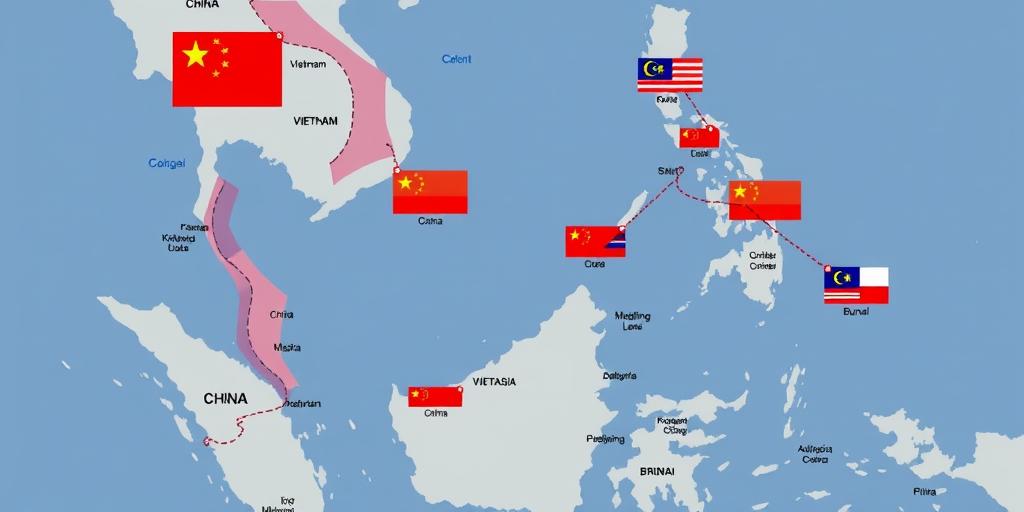The South China Sea: A Hotspot of Geopolitical Tension
The South China Sea is a strategic waterway and a focal point of geopolitical tensions in the Indo-Pacific region. This semi-enclosed sea, bordered by numerous countries, is rich in natural resources, serves as a crucial shipping lane, and is subject to overlapping territorial claims, making it a complex and potentially volatile area.
Key Players and Their Claims
Several countries have asserted claims over islands, reefs, and resources within the South China Sea. The primary claimants include:
- China: China claims the majority of the South China Sea based on its 'nine-dash line,' a historical demarcation that encompasses a vast area, including waters and islands close to the coasts of other countries.
- Vietnam: Vietnam asserts its sovereignty over the Paracel and Spratly Islands, citing historical evidence and international law.
- Philippines: The Philippines claims parts of the Spratly Islands and Scarborough Shoal, arguing that they fall within its exclusive economic zone (EEZ) as defined by the United Nations Convention on the Law of the Sea (UNCLOS).
- Malaysia and Brunei: These countries claim parts of the South China Sea that overlap with the Spratly Islands and their respective EEZs.
Strategic and Economic Significance
The South China Sea holds immense strategic and economic importance:
- Shipping Lanes: It is one of the world's busiest shipping lanes, facilitating trillions of dollars in trade annually. Control over these routes allows nations to exert influence over global commerce.
- Natural Resources: The sea is believed to contain significant reserves of oil and natural gas, making it a valuable resource for the surrounding countries. Access to these resources is a key driver of territorial disputes.
- Fishing Grounds: The South China Sea is a vital fishing ground, providing livelihoods for millions of people in the region. Overfishing and environmental degradation have further complicated the situation.
Escalating Tensions and Militarization
In recent years, tensions in the South China Sea have escalated due to several factors:
- Island Building: China has constructed artificial islands on reefs and shoals, equipped with military facilities, runways, and ports. This has raised concerns among other claimants and international observers.
- Military Presence: Increased naval and air patrols by various countries, including the United States, have intensified the security dilemma. The U.S. Navy conducts freedom of navigation operations (FONOPs) to challenge China's excessive maritime claims.
- Diplomatic Standoffs: Diplomatic efforts to resolve the disputes have been largely unsuccessful. Negotiations for a code of conduct between ASEAN and China have been slow and fraught with disagreements.
International Law and UNCLOS
The United Nations Convention on the Law of the Sea (UNCLOS) is a crucial framework for understanding the legal dimensions of the South China Sea disputes. UNCLOS defines the rights and responsibilities of states concerning the use of the world's oceans, including territorial waters, EEZs, and the continental shelf.
In 2016, an international tribunal at the Permanent Court of Arbitration in The Hague ruled against China's nine-dash line claim, stating that it had no legal basis under UNCLOS. China has rejected the ruling, further complicating the situation.
Implications and Future Outlook
The geopolitical tensions in the South China Sea have far-reaching implications:
- Regional Stability: The disputes pose a threat to regional peace and stability. Miscalculations or escalatory actions could lead to conflict.
- International Relations: The South China Sea issue has strained relations between China and other countries, including the United States, impacting broader geopolitical dynamics.
- Economic Consequences: Disruptions to shipping lanes or resource exploitation could have significant economic consequences for the region and the global economy.
Moving forward, it is crucial for all parties to adhere to international law, exercise restraint, and pursue peaceful means of resolving disputes. Enhanced dialogue, confidence-building measures, and cooperation on non-traditional security issues, such as environmental protection and maritime safety, can help mitigate tensions and promote stability in the South China Sea.









